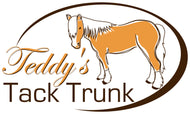Products to Help with Body Clipping Your Horse
I really enjoy clipping horses and have recently done several at my barn for upcoming horse shows. It really makes the horses look clean and pretty and makes winter grooming a breeze. However, in colder climates, blankets and turnouts are a must for a clipped horse, which is sometimes a hassle. Teddy does not get clipped for the winter but instead I do it in the Spring. He lives outside 24/7 and does not show, so I prefer that he keeps his natural, winter coat. Therefore, I don't blanket him either.
Anyway, here are some tips that you can use if you are clipping your horse.
It's best to start with a freshly bathed, dry horse. But that isn't always possible because of the cold weather or because a last minute clipping job is needed. However, it is important to get your horse as clean as possible to get the best performance from your clipper blades.
So, if you can't bathe your horse, use a curry comb to loosen as much dirt as possible, and then use a dandy flick brush followed by a body brush. Teddy's Tack Trunk offers a complete line of William Leistner brushes that are excellent for grooming your horse. For more information on these horse brushes, go to our Grooming Brushes & Tools collection page.
Next, you can get even more dirt and grime off of the horse with waterless shampoo, such as Espana Silk All Natural Waterless Shampoo. You simply spray your horse and then wipe off the dirt and grime with a towel.
The final preparation for clipping your horse is to spray him/her with a detangler, like EQyss Avacado Mist Conditioner Detangler or Espana Silk All Natural Detangler & Sunscreen. This will make your horse's coat smoother and will allow the clipper blades to glide through it more easily.
Now it's time to use the clippers, and please make sure that they are clean and oiled. Also make sure that your horse is completely dry before starting. The waterless shampoo and detangler sprays just take a few minutes to dry. Turn on the clippers and let your horse hear the sound of them. Gently place the body of the clippers (not the blades yet) on your horse's shoulder to let him/her know that you will be starting to clip. If you horse is calm and aware, you can start clipping. I usually start on the shoulder area and do one side first, then the next, followed by the legs and the head. Some horses are more sensitive on the legs and head so I might start with those areas just to get them out of the way. I also use a hay net for a horse that gets antsy, to give him/her something to do while clipping. Periodically, clean the clippers by brushing out the clogged hair, spray with coolant, and always oil them last, wiping off excess oil before starting to clip again. While you are clipping, use a body brush to clear the clipped hair and remaining dirt out of the way.
Once you are finished with clipping your horse, you might find that the horse has some type of skin fungus, such as rain rot or crud. Often times you can't see this prior to clipping, when the horse's coat is thicker. To keep this from spreading, these skin problems need to be taken care of. You can spot clean the areas with an anti-fungal shampoo, like EQyss Micro-Tek Shampoo or Espana Silk All Natural Antiseptic Shampoo, followed up with an anti-fungal spray, such as Zephyr's Garden Anti-Fungal Spray, EQyss Micro-Tek Spray, or Espana Silk All Natural Antiseptic Topical Spray. All of the products are all natural and made with the highest quality ingredients. It is best to do a daily treatment to get these skin conditions under control and these products are safe and effective to get the job done.












